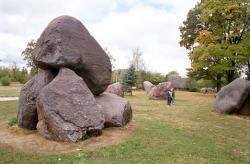The Balvi district is located in the North-East part of Latvia, in the North of Latgale, 219 km from the capital of Latvia Riga.
Alūksne district – in the north;
Gulbene district – in the west;
Madona district – in the south-west;
Rēzekne and Ludza district – in the south.
In the east it has national borders with Russia.
Gulbene district – in the west;
Madona district – in the south-west;
Rēzekne and Ludza district – in the south.
In the east it has national borders with Russia.
Area: 2381 km2.
40 % are occupied by forests, marshes constitute 10 % from the whole territory.
The district territory is rich in lakes – 47 (larger than 1 ha), whose total area is 12,8 km2. The largest Pērkonu lake occupies 2,3 km2, Balvu lake – 1,68 km2.
The district holds 17 national meaning specially protested objects of nature and territories, one should particularly mention 6 restricted marsh areas.
Administrative division: 2 towns – Balvi, Viļaka, as well as 19 parishes.
Number of population: 28,246 thousands . In towns – 34 %, in rural areas - 66 %.
Density of population: average in the district – 11,9 people/km2.
National composition: 77,8 % Latvians, 18,4 % Russians, 0,8 % Belarussians, 3 % other nationalities.
Where forests and firmament
Links songs with the lake-
Balvi on map of Latvia
Tomorrow’s garland shall make.
Links songs with the lake-
Balvi on map of Latvia
Tomorrow’s garland shall make.
(A.Vējāns)
Balvi town
Territory – 5,1 km2 or 508,7 ha
Town status granted – 1928
Town coat of arms - 1938
Town status granted – 1928
Town coat of arms - 1938
Balvi – a small originally beautiful and green town in the North-east of Latvia. Enclosed by two lakes North-east of Latvia. Enclosed by two lakes it is situated on the both sides of river Bolupe and possibly the Balvi lake and Bolupe river have given the name to the town. Another hypothesis is that the name of the town originates from the word “balva” that means a present. The name of Balvi is also connected with Baala – the deity of regenerating fertility, clouds, rain and thunder.
In ancient times this area was covered forests and marshes being part of Adzeles land inhabited by Latgals. For the first time Balvi was mentioned in 1224. In the 2nd half of 18th century the Polish landlady K.Hilzena at the Balvi lake builds half a manor and wooden church. In 1783 Balvi is mentioned as a village. On the interchange of 19-2o century Balvi has developed already as a large estate and parish centre. In 1926 Balvi is granted the status of hamlet and in 1928 – of town. In 1950 Balvi becomes a district centre.
Viļaka town
Territory – 637 ha of which 137,6 ha is occupied by Viļaka lake with an island holding the ruins of a Middle Age fortress.
Status of town granted - 1945
Status of town granted - 1945
